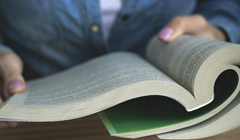- Ellen T. McKnight
- Tension in the Telling
 Tension is key to how we bring readers to care about our characters and what happens in our stories. That tension begins with character and gets expressed and magnified in plot, but the way we tell our stories is every bit as important. To complete my 6-part series on tension, I’d like to highlight some of the storytelling techniques that may be exploited as part of the overall orchestration of tension.
Tension is key to how we bring readers to care about our characters and what happens in our stories. That tension begins with character and gets expressed and magnified in plot, but the way we tell our stories is every bit as important. To complete my 6-part series on tension, I’d like to highlight some of the storytelling techniques that may be exploited as part of the overall orchestration of tension.
1. Writing in Scene
Writing in scene means something is taking place right in front of us, and we don’t know where it will lead. We have the most rawness and risk. This is true for the writer originally as well as for the reader: scene pushes us to discover our characters’ reactions in the moment. When events occur off-stage or in summary, we’re more shielded from uncertainty and the tension that goes with it. Scenes encourage us to show rather than tell and to make the fullest use of plot devices such as time pressure and suspense. (See Dynamic Tension in Plot.)
Despite the advantages of scene, summary may at times enhance the tension. It can help to avoid losing focus or dragging down the pace. To choose between scene and summary in a given instance, your sense of tension can help you decide. Sometimes a quick summary will better sustain the tension in your story’s forward line.
2. Emotional Impact
If your protagonist seems unaffected by what’s happening in the plot, then the tension dissipates. Why should readers care if the characters don’t? Donald Maass writes eloquently about the importance of including emotions in fiction in Third Level Emotions on Writer Unboxed. As you write, you need to keep asking yourself: how does my point-of-view character feel? Then you want to look for ways to convey that in story, including the techniques mentioned below and elsewhere on this blog. (See The Things We Carry.) For more, check out Don’s book, The Emotional Craft of Fiction: How to Write the Story Beneath the Surface, and Angela Ackerman and Becca Puglisi’s The Emotion Thesaurus.
3. Activating the Senses
Sensory details provide the most visceral experience of tension. We can use them to increase the tension in our characters and readers simultaneously. What is being seen, heard, touched, smelled, and tasted? Keep in mind that what we want readers to share is the filtered experience: details that give us insight into a character’s feelings, as well as bringing home the larger forces of tension at play in character and plot. If your protagonist is angry, then the food might taste awful. Or if the food tastes good, then the angry character might have trouble choking it down. Readers will pick up on that choking sensation on a physical level and share in the tension that triggers it.
4. Staging and Gestures
How close we stand and whether we touch are other physical clues that can affect readers directly. Do the characters keep a certain distance? What happens when they break it? What gestures do they make without being fully aware? Literary editor, writer, and teacher, Fred Shafer likes to ask writers, “Where are their hands?” How we move is revealing of how we feel, and can be a nuanced way to convey tension without wordy explanations. (See Movement with Meaning.)
5. Setting and Objects
The larger environment of your novel should reflect the protagonist’s fears and what he or she has to conquer, but within each scene, subtle aspects of setting can add to the tension. The closeness of a room, the atmosphere, the weather, the amount of light and noise, even the nature of objects. “Objective correlative” means that perceptions of objective things are colored by the feelings of the point-of-view character. If that protagonist of yours is still angry, then the furniture might be hard, the weather bleak. If it’s sunny, then it could be painfully bright. (See The Things We Carry.) The concept here is telling details. Details that tell us important things.
Also note that some objects are inherently loaded with tension: guns, knives, diaries, secret letters. Or writers can choose to load an object with meaning, such as Donna Tartt does with the painting in The Goldfinch. Acuteness of observation all by itself has a way of bringing things into focus and making them matter to readers. We listen harder when the details get crisp.
6. Poetic Power
Metaphors, imagery, and other figurative language can augment tension because of the associations they bring up in readers’ minds. A bird with a broken wing has meaning for us all. Writers can also infuse images with story-specific significance to carry import and tension from one point to another. Either approach can have the effect of exploding with meaning – the way sudden insight expands our vision.
7. Narrative Techniques
Readers can pick up on tension that is outside the protagonist. In first person, the protagonist may have blind spots or a certain obtuseness – he or she may report things, but not fully see. In third person restricted, this can go even further: even a virtually invisible narrator can include actions of which the protagonist is barely conscious, which can be quite revealing. In third person omniscient, this can go farthest of all – we can know thoughts in one head that are a complete mystery to another. But the trade-off in terms of tension can be the dispersal of identification. Readers may not as fully invest themselves on an emotional level with a series of point-of-view characters as they would with one.
When working with tension outside the protagonist, writers should try to reread their work with different experiences in the forefront. Read first for tension shared with the protagonist, then read again for all-inclusive tension. You never want to skip the former because you need to be sure to track how the protagonist is feeling throughout. A common error in genre fiction is for the writer to read only for overall tension. The protagonist can end up seeming relatively unaffected inside, as if he or she is shallow or amnesic. Good genre fiction has characters with authentic feelings.
8. Rhythm of Language
The rhythm of language itself makes a huge difference, both in creating tension and in sustaining it. Think of the oral storytelling tradition: holding an audience spellbound is about how a story is told as well as what is said. (See Making a Moment Count.) The words we choose and how we order them create a kind of music that contributes hugely to our experience of tension. These rhythms reach readers directly, akin to sensory data and figurative language.
The trick here is to match the rhythms of language to your intent. For example, try short, quick sentences for the kind of tension that goes with action. Experiment with sentence fragments when a character is under the most pressure. Try the probing quality of an extended sentence when the tension is mounting internally as a character moves toward unwelcome truth. Use the ends of paragraphs to leave a lasting impression. Held notes vs staccato. But don’t be afraid to mix it up either. The best music has variety as well as harmony, surprise as well as balance.
9. Final Thoughts
Because of the way tension resides in our guts, a range of sources can contribute. But as writers, we always need to exert some control. We want our instruments to be harmonizing – our subtler sources of tension to complement the larger ones. In addition, less is needed to sustain tension than to create it. Small content- or sensory-based hints will keep hearts thumping.
We also need to be careful of overwriting for tension. Restraint works better than hyperbole. Histrionics can turn readers off. Rather than forcing a moment to be bigger with lots of showy adjectives and adverbs, try to build your way up with strong verbs and specific nouns. Listen as you write to see what affects you the most. When you’re not writing, read books known for their powerful writing and learn from them.
Remember, too, that pace is different from tension. Tension can be slow, inexorable, quiet – too quiet. Hearing the machinery click in an empty room. Letting the pace slow doesn’t mean you have to lose tension. Details stand out that we didn’t notice before. In this way, a moment can take on significance and seem to enlarge. It can become a place for increased focus and sharpened perception.
Most of all, trust your gut. These are the kind of decisions that artists make. You’re an artist. This is what artists do.
My Tension Series examines the many opportunities for tension in fiction and ways to exploit and combine them, beginning with Tension: The Secret to Storytelling and concluding with this post. For more, visit ellentmcknight.com.
Writing Status Badges












Writing Status Badges












Featured Members (7)
Writing Status Badges























_thumbnail.jpg)




















